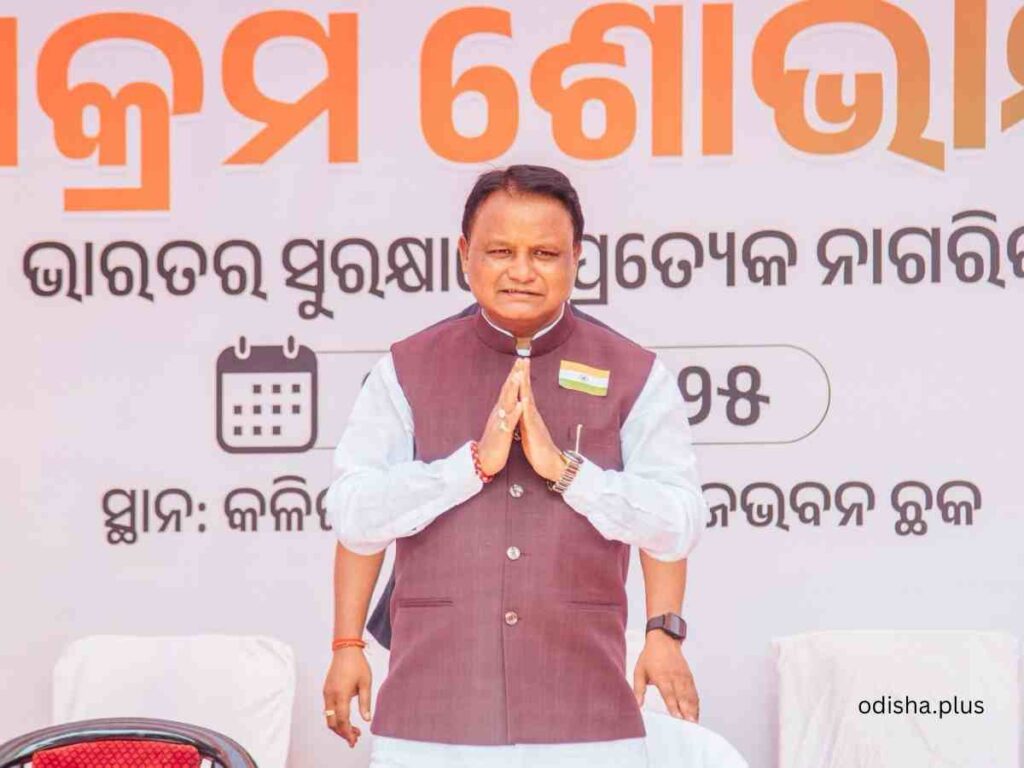While it is still too early to judge the long-term impact, the first year of the Majhi Government seems to convey a positive outlook
By Tejeswar Patnaik

As the Mohan Majhi-led BJP government completes its first year in power in Odisha on June 12, 2025, the political landscape of the state has witnessed a significant shift—both in tone and deeds. Within just twelve months, the new administration has launched several ambitious initiatives, aimed at restoring cultural pride, empowering the marginalized, reforming governance, and unlocking the state’s untapped potential. While it is still too early to judge the long-term impact, the first year of the Majhi Government seems to convey a positive outlook.
One of the earliest and most drastic moves by the Majhi government was its decision to abolish the previous BJD-led administration’s much-hyped “5T” framework. The decision signaled a conscious effort to decentralize power from bureaucrats and reestablish the legislature’s supremacy. The message was clear, that elected representatives would lead from the front, and governance would become more transparent, participatory, and accountable to the public.
In keeping with public demand. The government reopened all four gates of the iconic Jagannath Temple in Puri, This long-awaited gesture was widely welcomed by lakhs of devotees and religious leaders. Riding on this sentiment, the government further took the historic step of opening and renovating the Ratna Bhandar, the temple’s sacred treasury, which remained inaccessible for nearly four decades. Furthermore, a dedicated corpus of ₹500 crore has been allocated by the Government for the development work of Sri Jagannath temple.
Recognizing the pivotal role of farmers in the state’s economy, the government launched the Samrudha Krushak Yojana to bolster agricultural income and infrastructure. Under the scheme, the Minimum Support Price (MSP) for paddy was raised from ₹2,300 to ₹3,100 per quintal, with an additional incentive of ₹800 per quintal being directly credited to farmers’ bank accounts. This increase is one of the highest ever announced in the state and comes with a ₹5,000 crore budget for the fiscal year 2024–25.
To enhance transparency and reduce leakages, the procurement process has been digitized via the Krushak Odisha Portal, with a specific focus on reaching small and marginal farmers. Additionally, subsidies between 80% and 85% are being offered on agricultural equipment, reducing farmers’ input costs and boosting productivity.
In a landmark step towards gender equity, the state government launched the Subhadra Yojana, a flagship welfare program targeting close to one crore women across Odisha. Each eligible woman receives financial assistance of ₹50,000, along with access to healthcare services and opportunities for skill development. The scheme’s inclusive approach, covering both urban and rural populations, aims to strengthen the socio-economic status of women and foster long-term self-reliance.
Taking a citizen-first approach, the Chief Minister’s Grievance Cell has been revived to allow direct engagement between the public and the state leadership. Through the digital platform janasunani.odisha.gov.in, citizens can now lodge complaints online. Every Monday, the Chief Minister, along with ministers and senior officials, personally hears public grievances. So far, over 10,000 complaints have been addressed, with an impressive 88% resolution rate. Additionally, the CM’s visits to places like Sambalpur and Keonjhar underscore a governance model rooted in grassroots outreach.
The Antyodaya Gruha Yojana is a major push toward achieving “Housing for All” in the state. To build 2.25 lakh pucca houses for the rural poor, landless, and disaster-affected families within three years, the government has earmarked ₹7,550 crore for the scheme. Furthermore, the Government has announced the launching of affordable housing projects in Bhubaneswar and Cuttack, where homes will be priced between ₹15 lakh and ₹50 lakh for the low- and middle-income urban populace.
Odisha’s rural transformation has received focused attention through the Bikashita Gaon Bikashita Odisha program. Designed with a five-year vision and a budget of ₹5,000 crore, this scheme addresses basic infrastructure needs like rural roads, drinking water, school buildings, and village tourism. In the current fiscal year, ₹1,000 crore has been allocated for the program’s initial rollout, marking a strong beginning.
The government has prioritized primary education by introducing the Godabarish Mishra Adarsh Prathamik Vidyalaya scheme, aiming to upgrade 6,800 government primary schools into CBSE-affiliated model institutions. This is backed by a substantial allocation of ₹11,939 crore. Under the Saheed Laxman Naik Adarsha Ashram Vidyalaya Yojana, tribal residential schools are being modernized. The newly envisioned Tribal Swabhiman Bhawan will act as a cultural and linguistic hub, while the Madho Singh Hath Kharcha Yojana offers incentives of Rs 5,000 to tribal students to reduce dropout rates and improve learning outcomes.
In January 2025, the state hosted Utkarsha Odisha—Make in Odisha Enclave, which drew investment proposals worth ₹12.89 lakh crore from private corporates and public sectors. These investments are likely to generate substantial employment and boost the state’s industrial output. However, the Government needs to ensure the timely execution of these projects.For decades, the issue of land displacement, and environmental safety particularly in tribal areas, have been a matter of concern. The government should move beyond its traditional reliance on mining and encourage investments in sectors like automobiles, semiconductors, agro-processing units and green energy. Critical sectors like healthcare and education need deeper investment to bring about real transformation. Moreover, the migration of unskilled labour to developed states remains a challenge. This trend needs to be reversed.
In a move to showcase Odiya’s identity, the government initiated the construction of Odia Asmita Bhawan with a ₹200 crore budget. The creation of a separate Palm Leaf Manuscript Museum is also in the pipeline to preserve Odisha’s ancient literary heritage.
The observance of Odia Pakhya (Odia Fortnight) from April 1 showcased traditional Odia cuisine, art, dance, literature, and music across the state. These efforts reflect a renewed commitment to promoting the cultural pride of Odisha.
At the same time, people’s expectations from the Majhi Government remain very high. Key challenges like the Mahanadi river water dispute with Chhattisgarh and the Polavaram project dispute with Andhra Pradesh need to be resolved. The government should protect Odisha’s interests on these issues.
In addition, the State Government should deal sternly with mafias and land grabbers who are engaged in illegal mining and mineral theft, to protect natural resources. The government’s zero-tolerance stance on corruption is visible in its steadfast pursuit of anti-corruption drives against corrupt Government officials. Last year, the Vigilance Department registered 213 cases, against corrupt officials leading to the seizure of huge cash and illegal assets disproportionate to their income.
The state cabinet in a recent groundbreaking move announced increasing the upper age limit for state government job aspirants from 32 to 42 years, offering a fresh lease of hope to the state’s unemployed youth.
Chief Minister Mohan Majhi, during a NITI Aayog meeting, outlined his ambition of making Odisha a $1.5 trillion economy by 2047 in sync with India’s Viksit Bharat 2047 roadmap. Odisha’s 7.2% growth rate in 2024–25, higher than the national average, underpins this vision. Critical sectors like healthcare and education need deeper investment to bring about real transformation. Moreover, the migration of unskilled labor to developed states remains a challenge. This trend needs to be reversed.
It is worth acknowledging that during Naveen Patnaik’s tenure, Odisha‘s economy performed well exceeding the national GDP average. The State too witnessed great improvements in its multidimensional poverty and other indicators like women’s empowerment and health care. The state has the best disaster management and recovery mechanism in the country. The Majhi government inherited a legacy of a conducive economic environment and it must now raise the bar further through effective delivery and innovation. To fulfill the promises, it should walk the extra mile and go beyond the optics. Let its actions speak louder than words.
Critical sectors like healthcare and education need deeper investment to bring about real transformation. Moreover, the migration of unskilled labor to developed states remains a challenge. This trend needs to be reversed.
In just one year, the Mohan Majhi government has laid down an ambitious blueprint for Odisha’s transformation. From cultural revival and rural development to welfare schemes and clean governance, the state is moving in the right direction. With timely implementation, robust monitoring, and people-first policies, Odisha is poised to emerge as a developed, equitable, and self-reliant state in the years ahead.
(Sri Patnaik is a writer and Public affairs commentator. Views are personal)



























